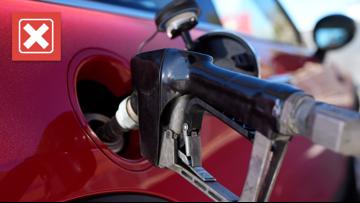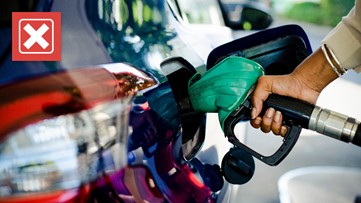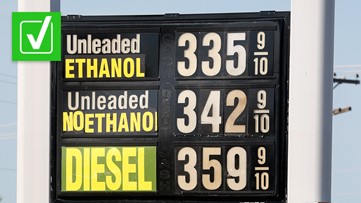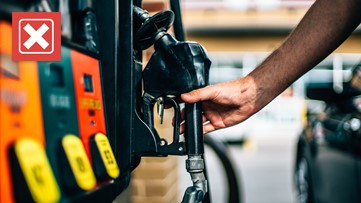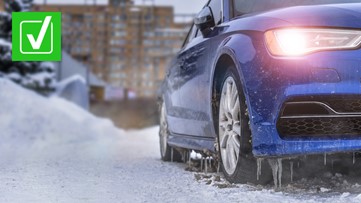While gas prices are no longer at record highs, they’re still above pre-pandemic levels. High gas prices prompt many people to look for ways they can save fuel.
You’ve probably heard about all sorts of tips and tricks to do that. We took a look at five ways to save money on gas and VERIFIED if they actually work.
THE SOURCES
- Fueleconomy.gov
- AAA
- Progressive Insurance
- Advanced Technology Institute
- NACS, a trade association for convenience stores and fuel retailers
- Code of Federal Regulations
- Consumer Guide Automotive, an auto-review organization
- DeBoer’s Auto, a body shop located in New Jersey
- Testing by scientists at Oak Ridge National Laboratory and Argonne National Laboratory
WHAT WE FOUND
Can the air pressure of your tires affect fuel efficiency?
THE ANSWER
You can improve your gas mileage by about 0.6% on average, up to 3% sometimes, by keeping your tires properly inflated, according to fueleconomy.gov. Your gas mileage lowers by about 0.2% for every 1 psi the average of all four tires is below the recommended tire pressure.
Testing by researchers at Oak Ridge National Laboratory found that fuel economy, which is your car’s miles per gallon, dropped by about 3% when tires were inflated to 75% of their recommended pressure, regardless of speed.
The lower the tire pressure, the worse the car’s fuel economy will be, especially when traveling at slower speeds. Oak Ridge’s researchers found that a 2009 Toyota Corolla experienced a 5% drop in fuel economy when its tires were at half of their recommended pressure and the car traveled at 80 mph. The Corolla experienced a 10% decrease in fuel economy when driving at 40 mph with tires at the same pressure.
You can find your vehicle’s recommended tire pressure by checking your owner’s manual or by looking for it on a sticker on the inside of the door frame of your car, Progressive Insurance says.
Will using premium gas when your car takes standard make your car more fuel efficient?
THE ANSWER
Premium gas won’t make your car more fuel efficient or give you any other benefit if standard gas is recommended for your car, which is the case for most cars.
The difference between premium gas and regular gas is octane, which is the ability of the gas to prevent engine detonation or "knock," AAA says. Uncontrolled knocking can cause severe engine damage, and the risk of knocking is greater in high-performance engines. That’s why the manufacturers for some sports cars, like the 2023 Chevrolet Corvette, recommend car owners use premium gas.
AAA says its testing found no increase in power or fuel economy when premium gas was used in cars designed to take regular gas.
Some high-performance cars require premium gas, but for others the manufacturer just recommends it. If that’s the case for your car, you can still use regular gas, but premium gas may provide small benefits to power and fuel economy, AAA and Progressive Insurance say.
But standard gas is recommended for the majority of cars, trucks and SUVs, Kelley Blue Book says.
You can check which kind of gas the manufacturer says you should use for your vehicle by checking the owner’s manual or looking it up online.
Will rolling down the window instead of using the A/C make your car more fuel efficient?
THE ANSWER
Between rolling down your windows and using the A/C, the most fuel efficient way to stay cool depends on how fast you’re driving and the kind of car you’re using. Rolling down your windows at lower speeds, like in the city, is more efficient than A/C, according to fueleconomy.gov. But at highway speeds, having the A/C on is more or equally efficient.
Testing has generally shown that in most situations you’ll use more fuel by running your A/C unit at its highest settings than you would use running your A/C at a lower setting or rolling down your windows so you can turn the A/C off entirely.
Driving with your windows down can reduce fuel economy in some circumstances, fueleconomy.gov says. That’s because when your windows are rolled down, air gets into your car and slams into the back window, creating drag that requires your car to use a little more power to overcome and maintain the same speed, the Advanced Technology Institute says.
A 2013 test by scientists at Oak Ridge National Laboratory found that both a 2009 Ford Explorer and a 2009 Toyota Corolla consumed more fuel with the A/C on at its max setting than when driving with the windows down, at both 40 mph and 70 mph. But at 80 mph, the Corolla wound up using more fuel with the windows down. The Explorer was still more efficient with open windows, even at higher speeds.
Testing dating as far back as 2004 highlighted by the Advanced Technology Institute differed on the details, but generally came to the same conclusions: you have to be going pretty fast before driving with the windows down uses more fuel than driving with your A/C on its max settings.
The 2013 Oak Ridge National Laboratory test also tested fuel consumption with the A/C running at 50% power. At this setting, rolling the Corolla’s windows down used less fuel up to 60 mph, when running the A/C became the more fuel efficient option. The A/C still wasn’t as efficient as driving with windows down in the Explorer until the car reached 80 mph.
If you do choose to use your A/C while driving at lower speeds, fueleconomy.gov recommends rolling down your windows when you start your car and waiting until you’ve started driving to turn on the A/C. Most A/C systems cool faster while the car is moving, and rolling down your windows when you first start your car lets out some of the hot air so your car can cool faster.
Is the gas at all gas stations the same?
THE ANSWER
Gas retailers across the U.S. use the same base fuel stored in common terminals, AAA and NACS, a trade association for convenience stores and fuel retailers, say. But you can’t buy base fuel at the pump because each retailer adds a different blend of additives.
These additives are designed to clean and protect the engine of a car, the NACS says. Without the additives, carbon deposits that reduce performance and fuel economy, and which cause other drivability problems, can build up on your car’s engine, AAA says.
The Environmental Protection Agency (EPA) requires all gas retailers to use a minimum level of additives it has determined can keep an engine clean, the NACS explains. According to EPA regulations, these additives must reduce an engine’s deposits to at least 10% compared to additive-free fuel.
While these standards helped minimize certain deposits, some automakers felt the standards did not go far enough, a 2016 study by AAA says. And so, in 2004, these automakers established a gas standard called “Top Tier,” which requires more additives that they say are of a higher quality. Long-term use of gas without an enhanced additive package, such as those used by gas stations in the Top Tier program, “can lead to reductions in fuel economy of 2-4%, drivability issues, and increased emissions,” the AAA study said.
The AAA study found that there were more harmful deposits in engines of cars that didn’t use Top Tier fuel than there were in cars that did use Top Tier fuel. It also found that Top Tier fuel brands were on average about 3 cents more expensive per gallon than other fuel brands at that time.
Top Tier’s website maintains a list of gas retailers that are certified retailers of the Top Tier gasoline standard. This list includes big national brands like Exxon and Shell, but also includes some local retailers without large chains.
But “Top Tier” gas stations aren’t the only retailers that sell high-quality gas, says Consumer Guide Automotive, an auto review organization. Some gas stations don’t bother with getting their gas certified as Top Tier because they have to pay a fee for it.
“This means that there are likely a number of gasoline retailers selling fuel that qualifies for Top Tier certification, but have chosen not to license the rights to say so,” Consumer Guide Automotive wrote in 2019.
DeBoer’s Auto, a body shop located in New Jersey, says that using discount gas on occasion likely won’t hurt your vehicle in the long run.
Is turning your car off and on more fuel efficient than idling for a couple of minutes?
THE ANSWER
Restarting your car while its engine is warm uses the gas equivalent of idling for 10 seconds, according to AAA and testing by researchers from Argonne National Laboratory.
A car engine uses between a quarter of a gallon to a half gallon of fuel per hour when idling, AAA says. The amount of fuel a warm engine needs to restart is less than 1% of that. Because of this, AAA recommends shutting off your engine if you’ll be stopped for more than a minute.
When you cold start an engine, or start an engine that isn’t already warmed up, you do use more fuel, Argonne National Laboratory’s researchers found. But engines take a while to cool down, so turning off your engine and restarting it after an amount of time “equivalent to a short transaction at a bank or restaurant” is unlikely to cause a cold start, keeping the amount of gas the restart takes low.
In fact, there are few situations in which you should let your car idle.
Many people think they should let their car idle on cold days to warm up its engine. But Linda Gaines, one of the researchers at Argonne National Laboratory responsible for the engine testing, says that there’s a better way to warm up your engine.
“Assuming that your windows are free of ice—safety first, of course—run the vehicle for about 30 seconds and drive gently (i.e., no hard acceleration),” Gaines said. “The engine will warm up more quickly by being ’at work’ than by idling, which will also help the car’s interior warm up more quickly.”
The one place where Gaines said it is better to let your car idle is when you’re stopped in traffic, but that’s for safety reasons.
“We don’t recommend turning your car on and off in stop-and-go traffic; driving safely means being able to respond quickly to traffic conditions,” Gaines said.


